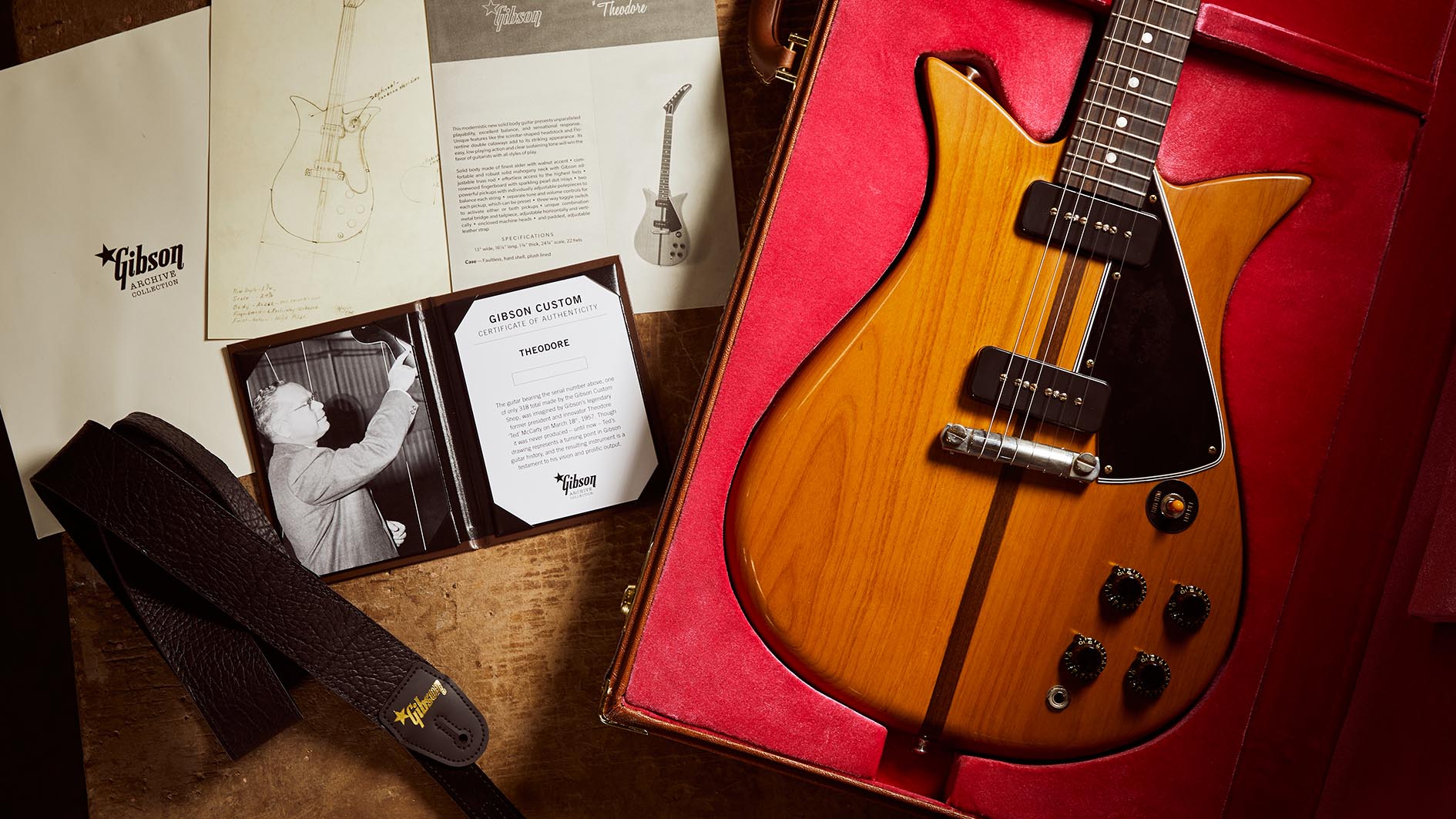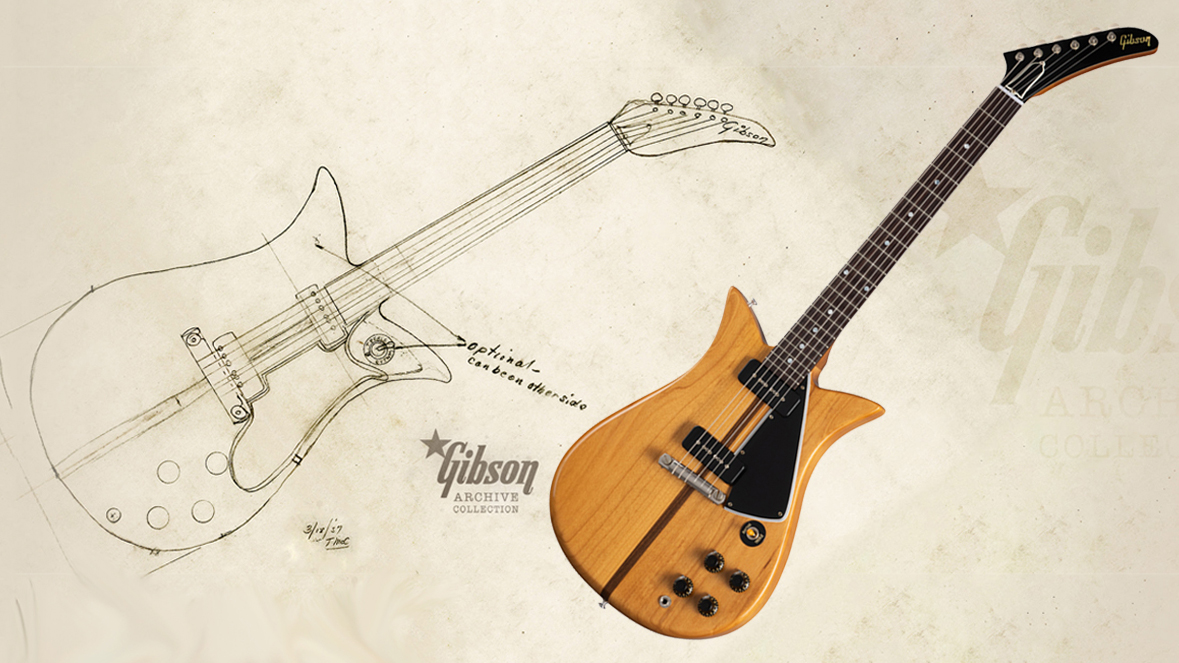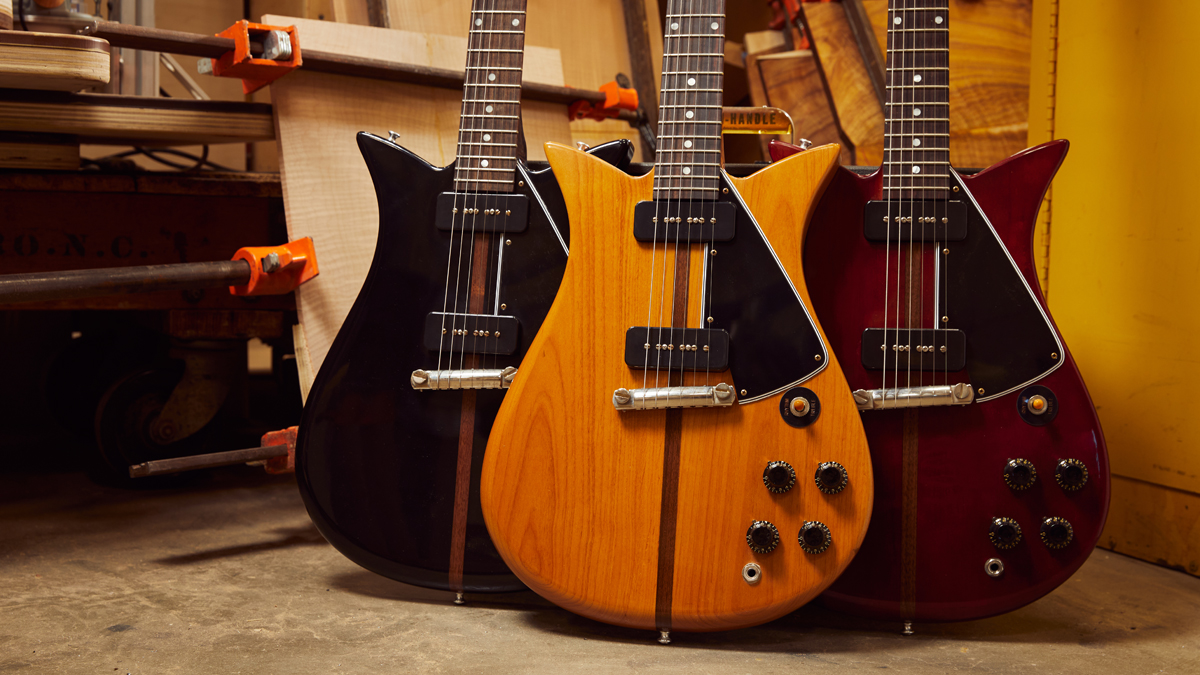How Gibson unearthed a 1957 Ted McCarty sketch and turned it into a new guitar shape for 2022, the Theodore
Senior Director of Product Development Mat Koehler recounts the guitar equivalent of “discovering King Tut’s tomb”, and reveals what's next for the model – as well as the “30 or 40 years’ worth of ideas” lurking in the Gibson archives

When it comes to electric guitars, the Les Paul, SG, Flying V and Explorer are all enduring household names. And rightly so. After all, these incredible designs have stood the tests of time and collectively played their part in establishing the Gibson brand as a market leader with a staggeringly rich sense of history – which, incidentally, is also still influencing and shaping the company’s future.
In a surprise announcement last week, the American giants unveiled the newest member in its all-star cast, the Theodore six-string electric. Except there was just one catch: this wasn’t a new guitar at all...
The double-cut electric guitar is the first model from the new Gibson Archive Collection, and inspired by a sketch drawn by former Gibson president Ted McCarty – the man who helped pioneer the brand’s aforementioned household names – dating all the way back to March 18, 1957.
And its arrival was most certainly big news, with guitar enthusiasts around the world taken by its two-piece alder body, reverse Florentine cutaways, Explorer-style scimitar headstock, off-kilter triangular pickguard and walnut center strip. Only 318 limited-edition models will be made in this initial Custom Shop run, nodding to the date of McCarty’s original schematic, with a choice of Natural, Cherry and Ebony finishes.
Other notable appointments include a chunky ‘57 C-shape mahogany neck, a 22-fret dot-inlayed rosewood fretboard, a wraparound bridge, historic Black Top Hat control knobs, Kluson tuners and a nylon nut.
And as for electronics, the Theodore will feature a pair of custom Soapbar P-90s hand-wired to the Gibson-standard control layout of two volumes and two tones. With eye-catching contours and cutaways, this next step in Gibson’s evolution could very well be another cult classic in the making…
Speaking exclusively to Guitar World, Gibson Senior Director of Product Development Mat Koehler talks us through the remarkable story of how he accidentally found McCarty’s 65 year-old design in their archives – initially thinking someone had played an elaborate prank on him – and how he took on the challenge of bringing a long-lost artifact from yesteryear into the present day, keeping it as close to McCarty’s blueprint as humanly possible...
Get The Pick Newsletter
All the latest guitar news, interviews, lessons, reviews, deals and more, direct to your inbox!
When and how did the conversation about resurrecting the Theodore begin?
“It’s an interesting story. Obviously, Gibson has been through a lot of changes over the last few years. This was something I discovered by accident and initially thought was a prank! [Laughs] As the Head of Product Development, I have access to the engineering archive and was looking around in early 2018, going through various files, blueprints and both formal and informal drawings… just all sorts of different things.
I think this is the most exciting thing to happen for guitars in a very long time. The designer of all the classic Gibson models also had this one in his back pocket!
“This felt a bit like discovering King Tut’s tomb. That was the feeling I had, because I’m a total Gibson nut that’s obsessed with all the Gibson mysteries, like why did they go to the narrow nut or change the neck profile for different models...”
One can only imagine what kind of information you have at your fingertips in there...
“Yeah, there are a lot of answers in that archive. But also 10 mysteries to go along with every answer I found! So I ran across a portfolio on lapsteels from the '40s, circa 1946 to be exact, and was definitely not expecting a Ted McCarty print to fall out of it. Maybe somebody from the company had put it in there to protect it? But I just didn’t know, which is why I kinda felt like I was being pranked!
“So I found this thing and showed it to my co-worker, and we both felt it could be the biggest guitar news in a long time. It was an incredible discovery.
“We asked all the old-timers if they’d ever seen it before and they all said no. I was in the Custom Shop at the time, but eventually I talked to Keith Medley at Gibson USA and he was like, ‘Oh yeah, I know that guitar, I’ve been wanting to do it since the '90s!’ He’d even mocked up a prototype back then but it never went anywhere. I was like, ‘Are you kidding me?!’
“Thankfully, he’d already vetted the existence of this print. And the more we researched Ted McCarty, his handwriting and other drawings for Gibson, the more the picture became clear. I think this is the most exciting thing to happen for guitars in a very long time. The designer of all the classic Gibson models also had this one in his back pocket!”

What can you tell us about that extremely eye-catching and unique double cut shape?
“They were using that shape on the EM200 mandolin, or at least one very similar to it. So I think that was the inspiration, and this guitar was almost like a continuation of that. Gibson refers to that shape as a double Florentine cutaway.
“As for the wraparound, that debuted in 1953. By 1954, they had the ABR-1 being used on the Les Paul Custom and that was eventually applied to the Goldtop. The Les Paul Junior and Special, however, always had the wraparound. So that’s another way of us being able to find out about the intention of the guitar, and it being more of a budget student kind of model.”
We have to ask: who came up with the idea of naming it after Theodore ‘Ted’ McCarty?
“So, it did not have a name originally. Finding the right one was a tough proposition. We were trying to figure out what this guitar was trying to be at the time. I think it’s likely that it turned into the double cut Les Paul Special, obviously with the Explorer headstock elements. It was a conglomeration of features that actually came later in Gibson history.
Cesar Gueikian threw out the name Theodore. And we all loved it – everyone thought it sounded fantastic
“It was confusing to know the exact intent of the guitar and then try to name it. In the midst of all this, my boss Cesar [Gueikian], who is the Brand President, threw out the name Theodore. And we all loved it – everyone thought it sounded fantastic.”
What can you tell us about the pickups? They certainly look like P-90s in the original drawing.
“Yeah, I think it was Ted’s intention to have P-90s. If you look at his drawing, you can tell he wasn’t an artist or engineer or drafter, so it’s a little crude, but you can tell they were either P-90s or maybe the New York-style Epiphone pickups. However, those ones didn’t even come into discussion until well after this drawing was made.
“So it must have been P-90s and not humbuckers, because they definitely don’t resemble humbuckers in the drawing. If they had wanted to, they would have used the ABR-1 stopbar. Because it has a wraptail, that’s what made me think it’s what turned into the double-cutaway Les Paul Special.”

The drawing specifies a natural finish. What made you decide on going with Ebony and Cherry as well?
“The drawing showed a center strip and also specified that the body material would be alder, which is very interesting. Ted specified a natural finish on this guitar, so that was the original intent, but we also tried to put on our 1957 caps and figure out what Gibson would have most likely done at the time.
“And the answer was, for a material like alder, it would have been darker colors to work with, just like the archtops. So that’s how we came up with the ebony and cherry finishes, also bearing in mind how well they worked against the walnut strip.”
It’s interesting, alder isn’t typically a Gibson-associated tonewood…
“In March 1957, they were heavily into discussions about what woods to use. We know that they were looking at lighter-colored woods. In fact, on the original concept drawing for the Epiphone Coronet and Crestwood in 1958, they specified poplar. So I believe they were considering poplar and alder at the same time.
If there’s demand and excitement for this model, then it’s very likely to spill over into Gibson USA
“And ultimately they were already using korina for lapsteels and they decided to give that a go on the Flying V and Explorer, because it’s a great-sounding wood and looked fantastic. But yeah, it is interesting to read about Gibson wanting to branch out into other woods back then.”
And as you mentioned earlier, the scimitar headstock might remind people of the hockey stick Explorers...
“They definitely wanted the six-in-a-line tuner headstock, which was kind of unique. This drawing predates what became the polished scimitar look. Ted wasn’t a drafter, so Larry Allers would have been responsible for what became the Explorer headstock.
“That headstock shape came about in late 1955. We actually uncovered some radical concept drawings for acoustic guitars, believe it or not, and one of them had that six-in-a-line headstock!”
That’s crazy! So, let’s cut to the chase: you’re lucky enough to have actually played one of these guitars. What do they sound like?
“I was lucky enough to not only trust my own ears but also listen to Joe Bonamassa playing one of these, for the video that we made. After he’d been ripping on it for a while, he and I agreed it definitely had that classic wraptail rawness, a brash kind of sound, especially with the P-90s. But it also sounded very different to a Special.
“Joe likened it somewhere in between a maple-top guitar and a Les Paul Junior kind of sound. It’s definitely a unique tone, for sure, but also very full-sounding across all strings. It’s a guitar that works well. Though our intention was to revive the spirit of the original design, it also happened to be a fantastic-sounding guitar.”
We laughed at his joke at the end about being gifted three of them and then noticing they were actually for Slash!
“He was joking about being gifted three. But he does want one… we haven’t been able to do that yet. Maybe there’s a chance Joe can get one of the protos! [Laughs]”
Ted McCarty was a constant tinkerer and innovator, in the same spirit as Leo Fender or Paul Bigsby. He was not only groundbreaking but also trying to push his own limits and figure out the next thing
Fingers crossed for him! As for Ted McCarty, it has to be said, he was as important as Les Paul himself when it comes to Gibson folklore...
“That’s exactly the story we wanted to tell in releasing this guitar. The Ted McCarty lore is long and clearly he had a great influence on all the classic Gibson models. Maybe a lot of people don’t know that he was a constant tinkerer and innovator, in the same spirit as Leo Fender or Paul Bigsby. He was not only groundbreaking but also trying to push his own limits and figure out the next thing!
“As soon as he started in 1948, he began innovating. His first patent was what is now known as the McCarty pickguard, which is the pickguard with pickups built in it. I actually have a 1949 L-7 with that pickguard – it’s brilliant and fantastic.”
Obviously, this initial Custom Shop run will be on the more expensive side. What are the chances of more affordable models later down the line?
“We wanted to follow the traditional release cadence. With an artist, for example, we would probably start at Custom Shop and then it would make its way through the rest of the range in various forms. For this one, we didn’t know how it would be received.
“Obviously it’s very exciting and big news, but we had to price it at Custom Shop prices where it was developed because there were so many unique features – like the radius on the body, which has that beautiful roundover that flattens out as it goes up the curves towards the cutaways.
“That was actually incredibly difficult to achieve, even with modern machinery, which could be one of the reasons why the guitar wasn’t put into production in 1957… they simply might not have had the means. So that’s why we started at Custom Shop in a limited fashion, and if there’s demand and excitement for this model, then it’s very likely to spill over into Gibson USA.”

As for what else to expect, please indulge us: is this the most radical, or do you have other long-lost designs on the way?
“There is so much more! But I guess this felt like the most concrete concept. Ted was a doodler, so he was constantly drawing all sorts of crazy body designs. And he didn’t sign everything either, but we’ve grown to recognize what he drew compared to what other engineers/designers like Larry Allers did. It’s really interesting to dig into all that stuff.
“If there are any more crumpled-up drawings that didn’t see the light of the day because they weren’t interesting enough at the time – well, actually I think everything Ted was playing around with was interesting and innovative – then there are so many different guitars that Gibson maybe made one of, or just a few.
Honestly, we have about 30 or 40 years worth of ideas here!
“I just posted a picture of Andy Nelson on my social media the other day, who designed the ES-355. In the photo he’s playing the prototype, which had a Byrdland or L-5 style neck on it. Stuff like that is very interesting, especially for this Archive series. We’re not just looking at drawings or never-seen-before blueprints; there’s also the stuff that’s cool and also impossible to get anywhere. That’s the whole idea.
“And it won’t just be Gibson – we want to do Epiphone Archive models as well. We did uncover a blueprint for a solidbody Epiphone from the early ’60s that had features of other models but had never been in production. So that’s a hint of what’s to come. But honestly, we have about 30 or 40 years’ worth of ideas here!”
- The Theodore is available now for $4,999. For more information, head to Gibson.
Amit has been writing for titles like Total Guitar, MusicRadar and Guitar World for over a decade and counts Richie Kotzen, Guthrie Govan and Jeff Beck among his primary influences as a guitar player. He's worked for magazines like Kerrang!, Metal Hammer, Classic Rock, Prog, Record Collector, Planet Rock, Rhythm and Bass Player, as well as newspapers like Metro and The Independent, interviewing everyone from Ozzy Osbourne and Lemmy to Slash and Jimmy Page, and once even traded solos with a member of Slayer on a track released internationally. As a session guitarist, he's played alongside members of Judas Priest and Uriah Heep in London ensemble Metalworks, as well as handled lead guitars for legends like Glen Matlock (Sex Pistols, The Faces) and Stu Hamm (Steve Vai, Joe Satriani, G3).
“I always felt like that record could have been better if we had worked on it some more”: Looking for a blockbuster comeback album, Aerosmith turned to Van Halen producer Ted Templeman. For Joe Perry, it served as a learning experience
Guitar World Discussion: Who is the most underrated guitar player of all time?













